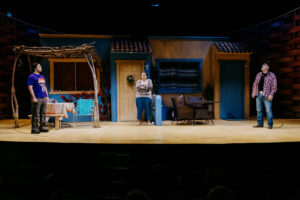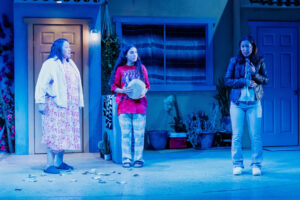Cashed Out
Claude Jackson, Jr.
San Francisco Playhouse

Walking into the theatre and seeing the impressive scenic design of Tanya Orellana, my expectations for San Francisco Playhouse’s world premiere of Cashed Out only increased. Already I was excited that this commissioned work coming from the Playhouse’s pandemic Zoomlet series of ten-minute plays is written by a Native American playwright, Claude Jackson, Jr., and features a cast of Native American and indigenous actors.
Pre-articles had informed me that the play is set in the very reservation where the playwright has lived – the Gila River Indian Community Reservation in Arizona – a community of the Pima known for their incredible skills in basket-making. The set indeed matched what I had read with its beautifully woven, circular walls that themselves look like a basket and that wrap around the two, side-by-side, desert-setting homes with their touches of Native American colors, baskets and blankets, and an open-framed, wooden ‘vatho’ in front of one (i.e., a native kind of latticed, shade structure).
Unfortunately, it took only the first few of the play’s many scenes to begin to sense that this world premiere still has issues to resolve before subsequent productions. Time jumps years in each of the first three scenes with no notice in projected supertitles of time passage nor little indication in the appearance of two of the primary characters that they have aged from age twelve to at least that many or more years in the future. An addiction to gambling is introduced in only the second scene with no rhyme or reason given as to how or why it developed – something the play never really explains adequately as the addiction and its consequences tragically play out. A mother evidently wracked by pain is clearly addicted to opioids and maybe also to cocaine, but we also never know exactly how or why that happened. (There is one later flashback of an abusive, alcoholic husband; but it is unclear if that is a turning point in the mother’s health and well-being).
Flashbacks repeatedly occur to an incident of the mother and her basket-weaving as she is observed by her young daughter (who is later the adult with the gambling addiction), but the flashback scenes with the adult daughter becoming her much-younger self (it appears) do little to signal to us that the daughter is once again twelve or when she switches back to her adult age.

The daughter’s own addiction to gambling is in many ways portrayed in script, direction, and acting in a manner often gripping; but at one point, the actor’s physical reactions seem more appropriate for a person with a drug addiction (frenetic, almost uncontrollable hand and body movements like we too often see on the streets of San Francisco’s Tenderloin). While gambling addictions certainly are reported to bring on anxiety, the director’s choices for the actor in this case seem overdone and even distracting from the scene where they are contained.
There is an unevenness in the flow during the evening. At times, the dialogue seems belabored and slow, even a bit mundane in the back-and-forth. At other times, speed picks up in almost a frenzy, especially in a turntable that spins with speeds through silent scenes to be almost startling.
And while there is an ongoing juxtaposition of the reservation’s famed, traditional skills for basket-weaving with its newer asset and influence of a major casino, what the play’s final message about the two is not totally clear to me. That is especially true after a rather abrupt final scene which once again takes a major leap in time and displays an unexplained, happy resolution of what up to that point has been a troubled relationship within the family. There is also no mention of the addicted daughter’s absence from the family gathering, with everyone there now very content.
All in all, there are a number of issues – a least for me – in the script that caused me increasingly to lose interest as the play progressed through its two hours, twenty minutes (with one intermission).
Something I have never experienced at SF Playhouse also occurred time and again in understanding some of the actors. Key lines of a member of the cast who plays a young, teenage girl were too often unintelligible due to a very soft, speaking voice and sometimes what sounded almost like a mumble. There were other times when a couple of the other characters had the same issues (particularly in the second half). These are things that clearly the director should have corrected before opening night.
While all these issues are for me troubling, there are certainly some highlights of the evening that meet and even at times exceed the high standards that San Francisco Playhouse productions have set during the past twenty years. Besides the aforementioned, wonderful scenic design, Michael Oesch’s lighting design is one of the most stunning I can remember seeing in a long time. The colors and designs employed against the basket-like, set-cupping walls never let us forget we are both in a desert setting and on a reservation with a history going back hundreds of years. Likewise, Ed Littlefield’s sound design puts us in the correct setting and mood from the moment we enter the theatre, with music then and throughout the evening employing the likes of reed flutes, native drumming, and rain sticks.

Even with a script and story that at times has some gaps and uneven characteristics, Sheila Tousey as the earth-mother-like Aunt “Nan” gives an award-worthy performance. Her Nan has a dry sense of humor that is delicious, with unexpected one-liners continually giving her the chance to provide her own home-spun advice to those around her as well as her running commentary on the events happening around her. At the same time, her devotion to her family and her tribal community is always forefront as she makes the kind of sacrifices that aunts and grandmothers have so often done in many cultures when their children and/or other, younger relatives collapse in their duties to their own children.
The devastating issues and subsequent effects on family and friends of addictions – be they alcohol, drug, or gambling – certainly are vividly and often painfully illustrated in Claude Jackson, Jr.’s Cashed Out. Present but not quite as clearly developed is healing potential of traditional arts and of the tight, native community itself. Unfortunately, in its first-time production at San Francisco Playhouse, Cashed Out has enough issues related to script, direction, and some of the acting that even with its important themes and Native American roots, I cannot heartily recommend it at this time.
Rating: 2 E
Cashed Out continues through February 25, 2023, in a world premiere production at San Francisco Playhouse, 450 Post Street, San Francisco. Tickets are available at www.sfplayhouse.org or by phone at 415-677-9596.
